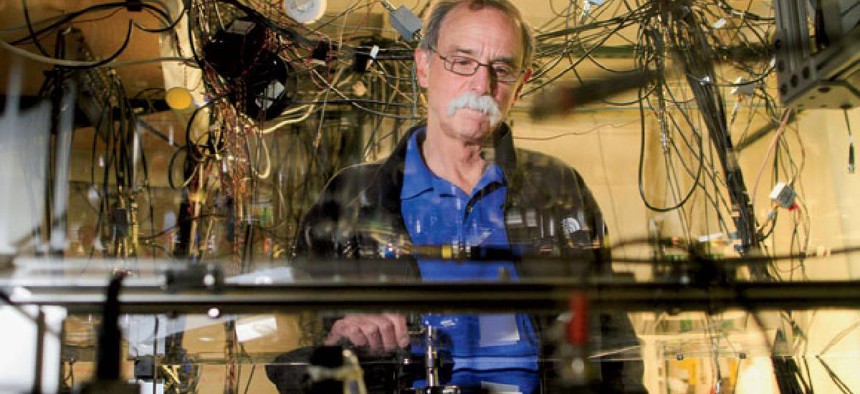
David Wineland received the Nobel Prize for his research in quantum physics. Barry Gutierrez/Landov
Nobel Pursuits
NIST scientist David Wineland’s work leads to the call of his life.
By Kedar Pavgi
People in government tend to associate the 3 a.m. phone call with a crisis. For National Institute of Standards and Technology scientist David Wineland it was one of the best surprises of his life. In mid- October, the Royal Swedish Academy of Sciences called Wineland in the wee hours at his Colorado home to inform him that he had won the 2012 Nobel Prize for Physics. He had only one word running in his mind: “Wow.”
Wineland was awarded the Nobel Prize alongside French physicist Serge Haroche for their research in quantum physics. His work has focused on controlling subatomic particles using lasers for further applications in atomic clocks and quantum computing. Wineland is the fourth NIST scientist in 15 years to receive the Nobel Prize, and one of the first to receive it in the quickly transforming field of quantum physics.
Wineland says in 1975 he chose to come to NIST because of the broad opportunities it offered. “I had my heart set on going into academia, but after looking at, and seeing what the real possibilities were, it just seemed that I would be able to do more if I came to NIST,” he says.
Wineland is the first to point out that his achievements are a team effort. His working group on subatomic particles—which includes scientists James Bergquist, Wayne Itano and John Bollinger—goes by the name Team Ions around the office.
Applications from their work are now used in everything from satellite technology and Global Positioning Systems to data servers needing critical time measurements.
Glossy Government
The Library of Congress has stepped up its government cool factor with a new magazine, LCM. The color glossy is a far cry from the library’s first publication, launched during World War II as a mimeographed newsletter. LCM’s first cover story details how the fledgling congressional library, which was burned by the British during the War of 1812, came back to flourish. Its collection has grown to 151 million manuscripts, photos, maps and movies—enough to fill the pages of LCM for years to come.
- Susan Fourney
Coordinating Camo
Best dressed is more than just a fashion statement when it comes to warfighting. But a recent report from the Government Accountability Office says the military services must better coordinate their uniform policies to fit missions and budgets.
Before 2002, all the services outfitted their troops with the Army’s version of the desert camouflage uniform. Since then each branch has introduced its own version to meet specific needs, according to GAO. Many of the changes have been technological, such as new fabrics that add flame resistance or blend into the environment.
The 2010 defense authorization directed the Pentagon to establish joint criteria for future ground combat uniforms, but limited guidance has failed to produce consistency, according to auditors. “Without a policy . . . the services could fall short of protecting all service members equally, potentially exposing a number to unnecessary risks,” the report said.
The cost of making new uniforms isn’t cheap either. GAO said replacing the Army’s battlefield uniform would cost nearly $4 billion over a five-year life span.
- Kedar Pavgi
Forever Fed
Sarkis Tatigian, the oldest Defense employee, is going strong at 90.
While many federal workers are looking forward to retirement in the next few years, 90-year-old Sarkis Tatigian has no immediate plans to hang up his spurs. The oldest employee in the Defense Department, Tatigian became eligible for retirement in 1973. Yet, this September he celebrated 70 years of service with the Navy.
Many public servants move on to new opportunities in the private sector, but Tatigian believes those who stay “do so because they like what they do.” For Tatigian, “a personal sense of accomplishment and reward” and a variety of experiences are what have kept him at the same agency for so long. He joined the Navy in 1942 as a junior radio inspector at the Naval Aircraft Factory in Philadelphia. While on active duty, he helped develop one of the first radar-guided missiles, the BAT, which was used in combat in 1945. Tatigian began his civilian career in 1946, and in 1979 he became associate director of the small and disadvantaged business utilization office.
“He helps steer billions of dollars that generate thousands of jobs across our country,” Sean Crean, director of the Office of Small Business Programs, said at the September event. “He has been part of the greatest Navy the world has ever seen, in the course of time that would easily be two or three careers for anyone else.”
- Chawndese Hylton
NEXT STORY: Around Government






